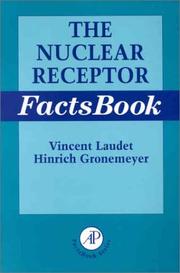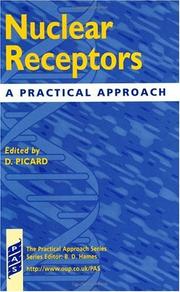| Listing 1 - 10 of 13 | << page >> |
Sort by
|

ISBN: 1281033235 9786611033231 0080537804 0124377351 9780124377356 9780080537801 9781281033239 6611033238 Year: 2002 Publisher: San Diego Academic Press
Abstract | Keywords | Export | Availability | Bookmark
 Loading...
Loading...Choose an application
- Reference Manager
- EndNote
- RefWorks (Direct export to RefWorks)
The FactsBook Series has established itself as the best source of easily accessible and accurate facts about protein groups. They use an easy-to-follow format and are researched and compiled by experts in the field.This Factsbook is devoted to nuclear receptors. The first section presents an introduction and describes the mode of action of the receptors in general. The second section of the book contains detailed entries covering each type of receptor.Entries provide information on: Nomenclature and structureIsolationDNA binding propertiesLigandsEx
Book
ISBN: 1620819716 9781620819715 9781612099804 1612099807 Year: 2011 Publisher: New York Nova Science
Abstract | Keywords | Export | Availability | Bookmark
 Loading...
Loading...Choose an application
- Reference Manager
- EndNote
- RefWorks (Direct export to RefWorks)
Book
ISBN: 9783031118364 Year: 2022 Publisher: Cham Springer International Publishing :Imprint: Springer
Abstract | Keywords | Export | Availability | Bookmark
 Loading...
Loading...Choose an application
- Reference Manager
- EndNote
- RefWorks (Direct export to RefWorks)

ISBN: 1280375698 9786610375691 019156592X 0585483728 9780585483726 9781280375699 1383049645 0199637431 Year: 1999 Volume: 207 Publisher: New York Oxford University Press
Abstract | Keywords | Export | Availability | Bookmark
 Loading...
Loading...Choose an application
- Reference Manager
- EndNote
- RefWorks (Direct export to RefWorks)
Nuclear Receptors, second edition, is a comprehensive guide to studying members of the steroid and nuclear receptor superfamily of transcriptase factors. It provides useful information for biomedical and clinical researchers.
Book
ISBN: 661178618X 1281786187 9786611786182 1435678001 6000006365 1607503271 9781435678002 9781607503279 1586038575 9781586038571 Year: 2008 Publisher: Amsterdam Washington, DC IOS Press
Abstract | Keywords | Export | Availability | Bookmark
 Loading...
Loading...Choose an application
- Reference Manager
- EndNote
- RefWorks (Direct export to RefWorks)
Focuses on the mechanistic involvement of nuclear receptors in cardiological, metabolic and neurological disorders. This book also focuses on possible explanation of pathways involved in pathogenesis, on susceptibility to and prevention of metabolic and neurological disorders, and on the aspects of drug finding.
Central nervous system --- Heart --- Nuclear receptors (Biochemistry) --- Nuclear hormone receptors --- Receptors, Nuclear (Biochemistry) --- Receptors, Nuclear hormone --- Hormone receptors --- Transcription factors --- Nervous system, Central --- Nervous system --- Diseases
Book
ISBN: 3030783154 3030783146 Year: 2021 Publisher: Cham, Switzerland : Springer,
Abstract | Keywords | Export | Availability | Bookmark
 Loading...
Loading...Choose an application
- Reference Manager
- EndNote
- RefWorks (Direct export to RefWorks)
Periodical
Abstract | Keywords | Export | Availability | Bookmark
 Loading...
Loading...Choose an application
- Reference Manager
- EndNote
- RefWorks (Direct export to RefWorks)
Nuclear receptors (Biochemistry) --- Récepteurs nucléaires (Biochimie) --- Periodicals --- Périodiques --- Nuclear Receptors --- Research --- Nuclear hormone receptors --- Receptors, Nuclear (Biochemistry) --- Receptors, Nuclear hormone --- Hormone receptors --- Transcription factors --- Cytology --- nuclear receptors --- General biochemistry
Book
ISBN: 9783319187297 3319187287 9783319187280 3319187295 Year: 2015 Publisher: Cham : Springer International Publishing : Imprint: Springer,
Abstract | Keywords | Export | Availability | Bookmark
 Loading...
Loading...Choose an application
- Reference Manager
- EndNote
- RefWorks (Direct export to RefWorks)
Nuclear Receptors focuses on the structural analysis of nuclear receptors from the initial work using isolated protein domains to the more recent exciting developments investigating the conformational shape of full-length receptor complexes. The book also reviews the structure of key nuclear receptor co-regulatory proteins. The aim is to bring together, for the first time, a comprehensive review of nuclear receptor structure and the importance of receptor conformation underpinning allosteric regulation by different ligands (hormone, drugs, DNA response elements, protein-protein interactions) and receptor activity. The nuclear receptor superfamily, including receptors for steroid hormones and non-steroid ligands, are pivotal to normal physiology, regulating processes as diverse as reproduction, metabolism, the immune system and brain development. The first members of the family were cloned over 25 years ago, which heralded in the idea of a superfamily of intracellular receptor proteins that bound small molecule ligands: classical steroid hormones, vitamins, fatty acids and other products of metabolism. These signals are then transmitted through multiprotein receptor-DNA complexes, leading to the regulation of target genes, often in a cell-selective manner. The cloning of the receptor cDNAs also ushered in an era of unparalleled analysis of the mechanisms of action of these ligand-activated transcription factors.
Biomedicine. --- Human Genetics. --- Endocrinology. --- Human Physiology. --- Medicine. --- Human genetics. --- Human physiology. --- Médecine --- Génétique humaine --- Physiologie humaine --- Endocrinologie --- ;. --- Pathology --- Genetics --- Medicine --- Biology --- Health & Biological Sciences --- Nuclear receptors (Biochemistry) --- Nuclear hormone receptors --- Receptors, Nuclear (Biochemistry) --- Receptors, Nuclear hormone --- Hormone receptors --- Transcription factors --- Human biology --- Medical sciences --- Physiology --- Human body --- Internal medicine --- Hormones --- Heredity, Human --- Physical anthropology --- Endocrinology .
Periodical
Abstract | Keywords | Export | Availability | Bookmark
 Loading...
Loading...Choose an application
- Reference Manager
- EndNote
- RefWorks (Direct export to RefWorks)
Histology. Cytology --- Physiology of nerves and sense organs --- Nuclear receptors (Biochemistry) --- Cell receptors --- Récepteurs nucléaires (Biochimie) --- Récepteurs cellulaires --- Receptors, Cytoplasmic and Nuclear --- Periodicals --- Périodiques --- Receptors, Cytoplasmic and Nuclear. --- Nuclear hormone receptors --- Receptors, Nuclear (Biochemistry) --- Receptors, Nuclear hormone --- Cytoplasmic Hormone Receptors --- Cytoplasmic Receptors --- Cytosol and Nuclear Receptors --- Intracellular Membrane Receptors --- Nuclear Hormone Receptors --- Nuclear Receptors --- Receptors, Cytoplasmic --- Receptors, Cytosol and Nuclear --- Receptors, Cytosolic and Nuclear --- Receptors, Intracellular Membrane --- Receptors, Nuclear --- Receptors, Nuclear and Cytoplasmic --- Cytoplasmic and Nuclear Receptors --- Cytosolic and Nuclear Receptors --- Hormone Receptors, Cytoplasmic --- Hormone Receptors, Nuclear --- Nuclear and Cytoplasmic Receptors --- Membrane Receptors, Intracellular --- Receptors, Cytoplasmic Hormone --- Receptors, Nuclear Hormone --- Hormone receptors --- Transcription factors --- Hormones --- Biology. --- Cytology --- Cytoplasmic Receptor --- Nuclear Hormone Receptor --- Nuclear Receptor --- Hormone Receptor, Nuclear --- Receptor, Cytoplasmic --- Receptor, Nuclear --- Receptor, Nuclear Hormone
Book
ISBN: 9048133025 9786612831331 9048133033 128283133X Year: 2010 Publisher: Dordrecht ; New York : Springer,
Abstract | Keywords | Export | Availability | Bookmark
 Loading...
Loading...Choose an application
- Reference Manager
- EndNote
- RefWorks (Direct export to RefWorks)
In 1890 a case of myxedema was treated in Lisbon by the implantation of a sheep thyroid gland with the immediate improvement in the patient’s condition. A few years later, medications for the then ill-explained condition of the menopause included tablets made from cow ovaries. In the first quarter of the 20th century the identification of vitamin D, and its sunlight driven production in skin, paved the way to the elimination of rickets as a major medical problem. Twenty years or so later, Sir Vincent Wigglesworth established the endocrine basis of developmental moulting in insects, arguably the most commonly performed animal behaviour on Planet Earth. A paradigm that would unify these disparate observations arose between 1985 and 1987 beginning with the identification of the glucocorticoid receptor and the nuclear receptor super-family. What follows is a timely and positive manifestation of the capacity, productivity and value of international human scientific endeavour. Based on intrigue, lively competition and cooperation a global effort has rapidly fostered a school of biology with widespread ramifications for the understanding of metazoan animals, the human condition and the state of the planet. This book is the first this century to try and capture the spirit of this endeavour, to depict where the field is now and to identify some of the challenges and opportunities for the future.
Nuclear receptors (Biochemistry). --- Nuclear receptors (Biochemistry) --- DNA-Binding Proteins --- Transcription Factors --- Cell Physiological Processes --- Proteins --- Receptors, Cytoplasmic and Nuclear --- Cell Communication --- Cell Physiological Phenomena --- Amino Acids, Peptides, and Proteins --- Chemicals and Drugs --- Phenomena and Processes --- Biology --- Cytology --- Health & Biological Sciences --- Biochemistry. --- Biological chemistry --- Chemical composition of organisms --- Organisms --- Physiological chemistry --- Nuclear hormone receptors --- Receptors, Nuclear (Biochemistry) --- Receptors, Nuclear hormone --- Composition --- Medicine. --- Endocrinology. --- Oncology. --- Cell biology. --- Biomedicine. --- Biomedicine general. --- Cell Biology. --- Animal Biochemistry. --- Chemistry --- Medical sciences --- Hormone receptors --- Transcription factors
| Listing 1 - 10 of 13 | << page >> |
Sort by
|

 Search
Search Feedback
Feedback About UniCat
About UniCat  Help
Help News
News